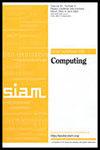The Computational Power of Frictional Mechanical Systems
IF 1.6
3区 计算机科学
Q3 COMPUTER SCIENCE, THEORY & METHODS
引用次数: 3
Abstract
In this paper we deene a class of mechanical systems consisting of rigid objects (deened by linear or quadratic surface patches) connected by frictional contact linkages between surfaces. (This class of mechanisms is similar to the Analytical Engine developed by Babbage in 1800s except that we assume frictional surfaces instead of toothed gears.) We prove that a universal Turing Machine (TM) can be simulated by a (universal) frictional mechanical system in this class. Our universal frictional mechanical system has the property that it can reach a distinguished nal conngura-tion through a sequence of legal movements if and only if the universal TM accepts the input string encoded by its initial connguration. There are two implications from this result. First, the mover's problem is undecid-able when there are frictional linkages. Second, a mechanical computer can be constructed that has the computational power of any conventional electronic computer and yet has only a constant number of mechanical parts. Previous constructions for mechanical computing devices (such as Babbage's Analytical Engine) either provided no general construction for nite state control or the control was provided by electronic devices (as was common in electro-mechanical computers such as Mark I subsequent to Turing's result). Our result seems to be the rst to provide a general proof of the simulation of a universal TM via a purely mechanical mechanism. In addition, we discuss the universal frictional mechanical system in the context of an error model that allows error up to in each mechanical operation. First, we show that for a universal TM M, a frictional mechanical system of this-error model can be constructed such that, given any space bound S, the system can simulate the computation of M on any input string ! if M decides ! in space bound S, provided that < 2 ?cS for some constant c. Second, we show that, for any universal TM M and space bound S, if we let = O(S ?1), there exists a frictional mechanical system in the-error model that can simulate M on any input which M decides in space bound S.摩擦机械系统的计算能力
在本文中,我们提出了一类由表面之间的摩擦接触连杆连接的刚体(由线性或二次曲面块表示)组成的机械系统。(这类机构类似于巴贝奇在19世纪开发的分析机,只不过我们假设的是摩擦表面,而不是齿形齿轮。)在本课程中,我们证明了通用图灵机(TM)可以用(通用)摩擦机械系统来模拟。我们的通用摩擦机械系统具有这样的特性:当且仅当通用TM接受由其初始构造编码的输入字符串时,它可以通过一系列合法的运动达到一个特殊的nal构造。这个结果有两个含义。首先,当存在摩擦连杆时,传动机构的问题是无法确定的。第二,我们可以制造出一台机械计算机,它具有任何传统电子计算机的计算能力,但只有恒定数量的机械部件。以前的机械计算设备(如巴贝奇的分析机)要么没有提供一般的状态控制结构,要么由电子设备提供控制(这在机电计算机中很常见,如图灵的结果之后的马克一号)。我们的结果似乎是第一个通过纯机械机制提供了一个通用TM模拟的一般证明。此外,我们在误差模型的背景下讨论了通用摩擦机械系统,该模型允许在每个机械操作中误差高达。首先,我们证明了对于一个通用的TM M,可以构造一个具有该误差模型的摩擦机械系统,使得给定任何空间界S,该系统可以模拟M在任何输入字符串上的计算!如果M决定!其次,我们证明了,对于任意通称TM M和空间界S,如果令= O(S ?1),则误差模型中存在一个摩擦力学系统,该系统可以在M在空间界S中决定的任何输入上模拟M。
本文章由计算机程序翻译,如有差异,请以英文原文为准。
求助全文
约1分钟内获得全文
求助全文
来源期刊

SIAM Journal on Computing
工程技术-计算机:理论方法
CiteScore
4.60
自引率
0.00%
发文量
68
审稿时长
6-12 weeks
期刊介绍:
The SIAM Journal on Computing aims to provide coverage of the most significant work going on in the mathematical and formal aspects of computer science and nonnumerical computing. Submissions must be clearly written and make a significant technical contribution. Topics include but are not limited to analysis and design of algorithms, algorithmic game theory, data structures, computational complexity, computational algebra, computational aspects of combinatorics and graph theory, computational biology, computational geometry, computational robotics, the mathematical aspects of programming languages, artificial intelligence, computational learning, databases, information retrieval, cryptography, networks, distributed computing, parallel algorithms, and computer architecture.
 求助内容:
求助内容: 应助结果提醒方式:
应助结果提醒方式:


